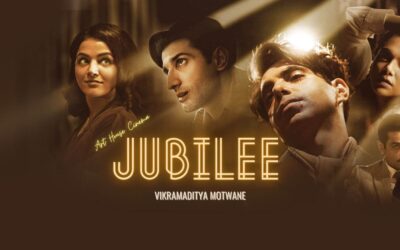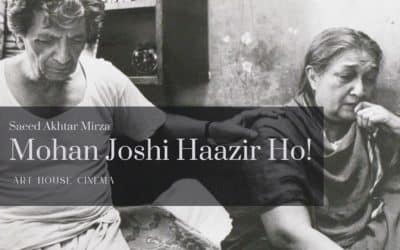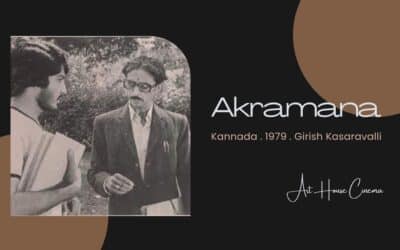Om Dar Ba Dar is a 1988 Hindi film directed by Kamal Swaroop. This film is considered a pioneer in the Indian Avant-Garde cinema and has become a cult classic with a section of viewers with its post-modernist approach extending to absurdist.
Cast
- Anita Kanwar ———————- Phoolkumari
- Aditya Lakhiya ——————- Om
- Gopi Desai ————————- Gayatri
- Lakshmi Narayan Shashtri — Babuji
- Lalit Tiwari ————————– Jagadish
- Manish Gupta ——————— Om
Story
Om Dar Ba Dar is the story of Om an adolescent boy in an imaginary town somewhere in India. The film traces the life of Om during his carefree young days and its surreal illusions. His father, Babuji is a former government servant who has left his job to dedicate his time to astrology. Om’s elder sister Gayatri considers herself equal in stature with men and sits in the men’s section in the theatre bring home her point. She is in a relationship with a good-for-nothing young man from Jhumri Talaiya, Jagadish, who fell in love with her boldness and the fact that she has been requesting the same songs as him on Vividh Bharati for years.
Om is popular in his school by virtue of some of his antics like holding the breath in water for a long time. Gayatri is gifted a bicycle by her father and Jagadish takes the responsibility of teaching cycling to her. As Babuji sets up an astrology centre, he keeps Jagadish as a typist. However, one day a lady named Phoolkumari comes to seek counsel from Babuji and since she is unable to pay, she is kept as the new typist, replacing Jagadish. Enraged, Jagadish breaks off with the family and goes away, not before Gayatri makes him get physically involved with her.
Om has become an adolescent now and has developed an attraction for Phoolkumari. One day a rich businessman, Lala Lotamal comes to Babuji and gives him his shoes for safekeeping, with diamonds hidden in the soles. One day, Om runs away from home, wearing Lala Lotamal’s shoes, however unaware that there are diamonds inside. Babuji suspects Phoolkumari and she places a curse on him that he will die the instant he leaves his room. Om arrives at Lala Lotamal’s grounds where the diamonds fall off and are swallowed by frogs.
Meanwhile, Lala Lotamal comes back to claim his diamonds. Babuji somehow convinces Lotamal that he has crushed the diamonds and mixed them in food and served him and that Lalaji should hold his bowels for 15 days and defecate only in the middle of the night where no one can see him. This way he will sow diamonds everywhere in his grounds and will be able to reap many more. Lalaji goes to his grounds and Om spots him in the act and Lala appoints him as the guardian of his land. Om starts catching the frogs and selling them to girls in a nearby school for dissection during their biology classes.
During dissection, one of the girls finds a diamond in the stomach of a frog. Soon word spreads and a mob arrives at Lala’s lands for a frog hunt. Lalaji thinks that the diamonds are produced from his faeces; he tries to stop the mob and is shot dead.
Om returns home and Babuji, in an attempt to catch him, comes out of his room and dies. Om goes to Pushkar and is spotted by a priest for his skills to hold breath underwater. The priest uses Om to make money from the pilgrims of his tricks. However, one night Om fails to surface above the water and his dead body comes up floating.
Jagadish comes back to Gayatri and they decide to commit suicide together by consuming Potassium cyanide, but only after telling its taste to the world. Jagadish takes the poison first and utters the word “Gobar” before dying, implying that cyanide tastes like cow dung. Gayatri changes her mind and the film ends with her returning home, alone on her bicycle.
Commentary
Om Dar Ba Dar evokes extreme emotions in those who watch it, while some consider it as one of the greatest films ever made, some others dismiss it as too weird. Though the story may appear linear at least on paper, it is not quite so in the film. The film does not have a collective meaning, not because of the incompetency of the director but because this is what the auteur film makes wanted it to be, a carefully constructed nonsense. The happenings and going on in the film defy the rules of film making, of the concept of framing and time and appear to come and go in an irregular and non-chronological order. The dialogues of the film shock and disturb with their carefully synchronized randomness which seem to be giving a different meaning, but which the viewer seems to miss by a whisker.
Some of the examples of the dialogues are:
Gayatri: “Tujhe kaise pata barish hone wali hai ?” – “How do you know it’s going to rain?”
Om: “Tu Kangi jo kar rahi hai” – “Because you are combing your hair
Consider one more:
Babuji: “Om tu mere kamre mein aaya tha?” – “Did you come into my room Om?”
Om: “Kyun?” – “Why?”
Babuji: “Rocket kaun udaa raha tha?” – “Who was flying rockets?”
Om: “Roos aur America.” – “Russia and America”
In the middle of all this nonsense, the director leaves clues to be picked up. These clues are deliberately so random that put together they do not make one single logical conclusion.
Om is obsessed with Rana Tigris or frogs. Once reading aloud, he says, “Aatankari tadpole mendhak banne se inkar kar diya tha” (“The terrorist tadpole had refused to turn into frogs”). The social, political and religious interpretation of this seemingly random sentence can vary hugely with each individual and with each viewing. The film is replete with such symbolism. Sigmund Freud would have clapped with joy, given a chance to review this film. For instance, Gayatri’s sexual encounter with Jagdish has juxtaposed with her father cycling furiously in circles symbolic of the superego. (Ref: Lalaland and Reel Life)
A satire on the nation or a surreal adventure, Om Dar Ba Dar refuses to fit into any genre. It is an attack on the senses and a stimulant at the same time. Om Dar Ba Dar cannot be completely interpreted, every frame seems to have more than one meaning, or motive to be there, and this is what makes this film immensely watchable or totally avoidable. It all depends on who is watching, like the glass pieces in a kaleidoscope, no two will see the same film between those reels of celluloid.
The Music of this film is another remarkable feat. Be it “Rana Tigrina” or “Meri Jaan AAA”, the songs are as different as the film itself is.
“Aaa Kood, Isme Khazana Chhupa Hai”
Awards
- Filmfare Critics Award for the Best Film (1989)
References
Om Dar Ba Dar On YouTube
Om Dar Ba Dar trailer on YouTube






